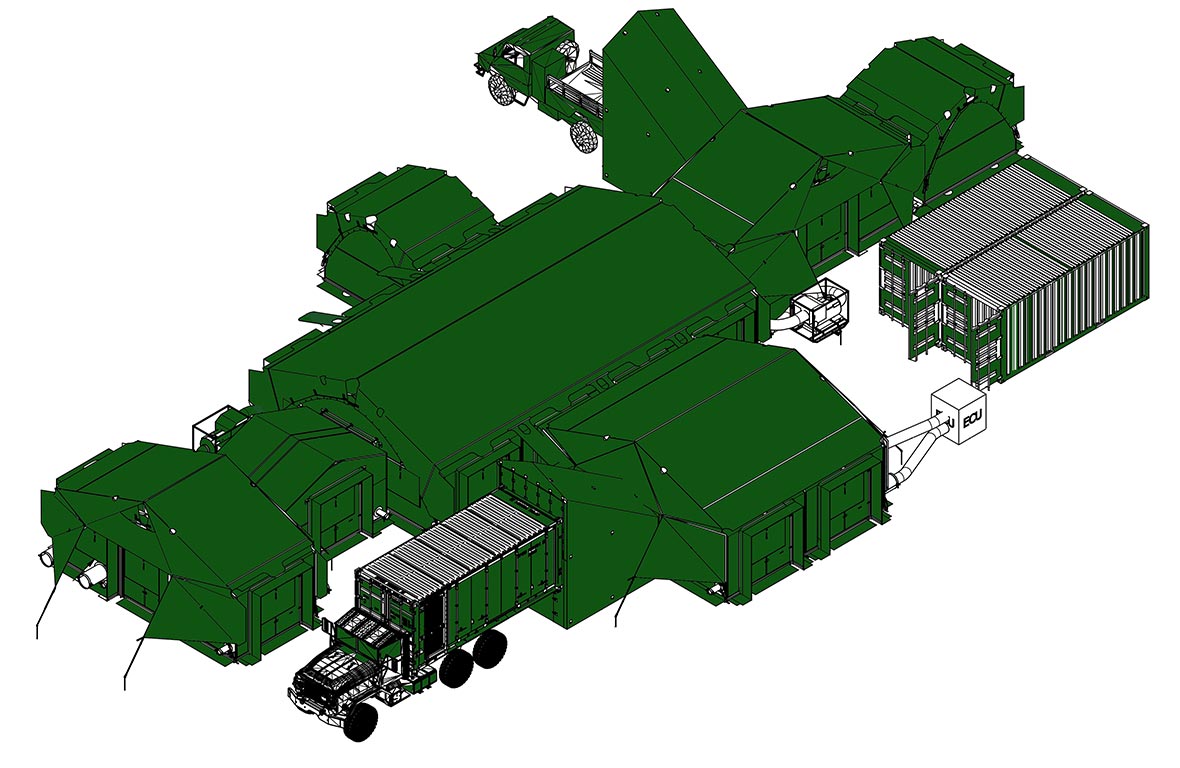Headquarters shelter system
Image gallery
The Headquarters Shelter System Project
Project summary
The Government of Canada is purchasing up to three sizes of tactical shelter.
The initial contract for purchasing the equipment is about $154 million and will cover 5 years to 2022. The initial contract for in-service support is about $14 million and will cover 5 years to 2022. Following the first 5 years, the department will have an option to extend in-service support for up to 20 years to 2042.
The shelters will have the command post function of an operations area, a planning area, and office and utility areas. The shelters can also serve as accommodations and medical facilities and will be capable of connecting to in-service vehicles and vehicle-mounted hard shelters. The system will include tactical lighting equipment, heating, ventilation and air conditioning equipment, and a semi-rigid flooring system.The Headquarters Shelter System project will dramatically improve the Canadian Army’s capability to plan, coordinate, and command its forces during training and deployed operations. They will provide a modern command post shelter system for all unit and brigade headquarters, protect equipment and personnel from the elements, and operate in all environmental conditions.
Project phases

Currently in Phase 4: Implementation
1. Identification
1. Identification
- April 2010
2. Options analysis
2. Options analysis
- 2011
3. Definition
3. Definition
- Waived
4. Implementation
4. Implementation
- Project approval implementation: August 30, 2012
- Contract award: January 13, 2017
- First delivery: early 2019
- Initial operational capability: 2019
- Full operational capability: 2021
5. Close-out
5. Close-out
- 2022
Learn more about the Defence procurement process.
Additional Information
Project updates
Project updates
July 2019
Deliveries of the shelter system have started.
February 2017
The Government of Canada announces on February 8, 2017, Weaherhaven is awarded two contracts to deliver the Headquarters Shelter System. One contract is to procure shelters and related equipment. The second provides five years of initial in-service support. The two contracts are valued at about $168 million (taxes included). If additional shelters are purchased and if in-service support options are exercised, the contracts could be valued at up to $350 million (taxes excluded).
April 2014
A draft Request for Proposal was released, including technical specifications.
Benefiting Canadian industry
Benefiting Canadian industry
The Industrial and Technological Benefits Policy applies to this procurement, requiring the company Weatherhaven to undertake business activities in Canada equal to the contract value.
Technical Information
Technical Information

The HQSS project includes the procurement of 1435 shelters with an option for an additional 338 shelters.
This includes:
- up to 467 Connector Hubs
- up to 1,718 Black-Out Vestibules and Hard Doors
- up to 442 Vehicle Boots
- up to 8,500 Tactical Lighting Kits
- up to 100,000 m² Semi-Rigid flooring
- up to 1,170 Air Conditioners
- up to 1,219 Heatersup to 1,025 containers
Project costs
Project costs
Initial Contract
The initial equipment acquisition contract is about $154 million (including taxes). Final deliveries are expected in 2022.
The initial in-service support contract is about $14 million (including taxes) and will cover 5 years to 2022. This includes the first 5 years of in-service support.
Extended in-service support
Following the first 5 years, the department will have an option to extend in-service support for up to 20 years to 2042. The government may exercise these options in increments of 5 years based on contract performance.
Together, the initial acquisition contract and the extended in-service support contract could be valued at up to $350 million (excluding taxes).
Full lifecycle costs
The full lifecycle cost of the HQSS project is $366.2 million (excluding taxes). This is an estimate that includes initial costs, extended in-service support, as well as services such as:
- project management costs
- contracted support costs, including spare parts, engineering support and repair and overhaul
- tools and test equipment
- equipment disposal
- maintenance personnel costs
- fuel
- training personnel costs
The calculation of a full lifecycle cost covers the period from which the project started in 2010 up to 2042. Contingency to account for risk and uncertainty is also included in the estimate.
